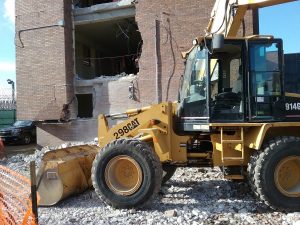Cook County demolishing jail buildings
By Kevin Beese For Chronicle Media — December 5, 2016
A bobcat is parked in front of one of the underutilized County Jail buildings being razed. (Photo by Kevin Beese/for Chronicle Media)
Razing some of the oldest holding cells at Cook County Jail will save taxpayers $188 million in capital costs over the next decade.
With the jail’s population at its lowest level in 25 years, and 20 percent lower than when Cook County Board President Toni Preckwinkle took office in 2010, it was determined that closing and demolishing three underutilized buildings of the jail — divisions 1,3 and 17 — was achievable.
“This is a huge step toward a criminal justice system that is more efficient and responsive to individual circumstances and less costly to taxpayers,” Preckwinkle said. “Bringing down the jail population is allowing us to bring down buildings and bring down costs. As we see declines in the number of detainees, it is logical and fiscally responsible to reduce the number of divisions at the jail.”
Cook County Sheriff Tom Dart said two of the buildings have sat dormant for several years because of a declining jail population and economizing resources.
“These three buildings were built as far back as the 1920s and are in need of constant and costly repairs,” Dart said. “We will continue to work toward ensuring efficient housing on the jail campus — a significant step for those of us who believe in running the criminal justice system fairly, humanely and cost-effectively.”
The demolition of divisions 3 and 17, and their 135,000 square feet of space, will be completed in 2017. Razing of the larger Division 1, with 344,000 square feet of space, will follow in 2018.
County Commissioner Stanley Moore, chairman of the County Board’s Law Enforcement Committee, said the jail population has been reduced by mental health initiatives and legislative action in Springfield, spearheaded by Preckwinkle and Dart.
“This is a visual representation of the achievement of the population reduction at Cook County (Jail),” Moore said last week, standing with other county leaders in front of demolition equipment at the jail divisions, located near 27th Street and California Avenue in Chicago. “This was a collective effort of several Cook County criminal justice stakeholders that has allowed us to witness the lowest (jail) population level since 1991.”
The demolitions are expected to save the county $3 million in expenses alone during fiscal year 2017.

Cook County Sheriff Tom Dart (at podium) talks about the demolition of three underutilized buildings at the County Jail. The razing of the three jail divisions will save the county $118 million over 10 years. Officials behind Dart are (from left) county Commissioner Stanley Moore, County Board President Toni Preckwinkle, county Commissioners Pete Silvestri and John Daley and (at far right) Chicago Ald. George Cardenas. (Photo by Kevin Beese/for Chronicle Media)
“By demolishing buildings, we can begin to make headway on reducing our fixed criminal justice expenditures, a benefit to the county and all its taxpayers,” Preckwinkle said. “The more money we spend on unnecessary pretrial detention, the less money we have for other purposes.”
According to the County Board president, bringing the jail buildings up to par would cost an estimated $188 million over the next 10 years.
She said not spending money on the unneeded jail building improvements will help stabilize the county’s finances and redirect funds to other areas, such as education, mentoring, job training, job placement and treatment programs in communities throughout the county.
Preckwinkle said reducing the jail population has been achieved by releasing individuals accused of nonviolent crimes who are neither a flight risk nor a threat to the community while they await trial. She noted the action has not generated an increase in the number of individuals who fail to appear in court or individuals arrested on new charges while on pretrial supervision. Those numbers have continued at 2 percent for court no-shows and 4 percent of newly charged despite far more individuals being released from the county holding facility.
“Those are the same numbers as when we had 10,000 people in jail,” Preckwinkle said.
She said in an effort to cut no-shows even further, the county is looking at implementing a court reminder call system that will alert charged individuals of an upcoming court appearances.
“We routinely in this country get phone calls if we have a dental appointment or a doctor’s appointment to remind us to show up,” Preckwinkle said. “We need to do the same thing for people who have hearings or trials coming up,”
Sheriff Dart said for far too long the County Jail has been used as a dumping ground for individuals with mental illnesses.
“What type of society are we that we dump them in here?” Dart asked. “They don’t need to be here. Through a lot of the work we have been doing for the last few years we have been able to get a lot of those people out of here and that is what this division used to hold. This would hold minimum (security) people, people who had issues, people who had low-level offenses.”
Dart said downsizing of the jail population has occurred “by getting the wrong people out of jail so we have space for the right people.”
The sheriff said the three divisions targeted for demolition were outrageously expensive to upkeep and very old.
The demolitions will drop the jail’s capacity from 11,300 to 9,600, a 15 percent decrease. Dart said the county can still easily handle a spike in incarcerations should one occur.
“There is long-term ability to keep population down, having the right people in here,” Dart said. “We’ve talked about this. We will have a back-up plan.”
Read the current issue of the Cook County Chronicle
Free subscription to the digital edition of the Cook County Chronicle
— Cook County demolishing jail buildings —






